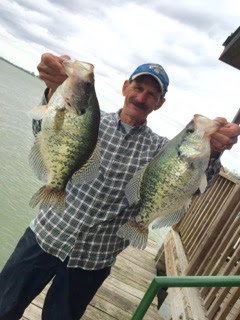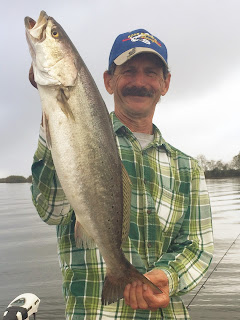Into The Deep for Crappie
Bobfishtales.......
Perhaps the number one question about fishing different places is how to adjust from shallow water to deep or vice versa.
Being from the very deep south, where typically the marsh is an average of 5-8 feet, going to a lake or area where the water may be up to 30-40 foot deep can be a daunting task. After all, the typical technique for the South is a jig under a cork fished about 18 inches deep. That is an easy adjustment for folks that fish the deeper lakes. But adjusting from south to north is more involved. If you are a novice fishing a new body of water, you may need at least one day just to explore. It is imperative to have a good depth/fish finder. Two preferably, one dash mount and one mounted on the trolling motor. This will aid in finding structure as well as the depth of the fish. Unless crappie are spawning in shallow water, the single pole cork method won't be as effective. You can use the cork method in these type of places, but a slip cork may be needed. Sometimes you will find fish 3 foot deep and sometimes 20 feet or more. This all depends on time of year and water temps. Another reason for a fish finder is that most units will give you the surface temperature. This could be important for locating active fish. Finding information on the best areas is also imperative. The last thing you would want to do is to fish areas without structure or fish. Then to explore, finding where others, particularly the locals, are fishing can benefit in catching more fish. Most of those folks are willing to share their expertise. Now the important thing, adjusting your technique. Tight lining is probably the most effective way to catch more crappie. Whether it is single pole,learning to spider rig or using the pole in each hand method. A 10-12 foot crappie pole is the norm for this type of fishing. A jigging pole is better if you are not spider rigging. They are lighter and usually better for feeling the bite. Plus it won't tire you out. Tight lining allows you to explore different depths easily. Typically, a heavier jig head is recommended. Fishing the marsh or shallow water, a 1/32 or 1/16 oz jig works well. In deeper water 1/16 to 1/4oz may be needed. If tight lining is not your thing, using a slip cork may be what you need. A slip cork allows you to adjust to deeper depths. Bait wise, fishing the shallow marsh or the deepest lake are not much different. Those colors that work well in the South, will work well in the North. And as always, you can't go wrong with live bait. The simplest method and easiest way to catch crappie is to tie on a weight and hook, used with a live minnow. You can buy these already assembled at you local tackle store. A light wire hook works well from a number 6 to a 1/0, and usually will bend and pull off if you get hung up. This will save you time re-tying. Line size depends on water clarity and structure. If fishing heavy cover a heavier line is needed. Braid works well for this also. The thinner diameter allows you to use heavier pound test on the same reel that lighter line is used. This can help pulling off hang-ups and feeling the bite better. So if you are thinking about heading to deeper water, just a few adjustments may help you net you more fish. Good luck fishing. Hope to see ya on the water





Comments
Post a Comment